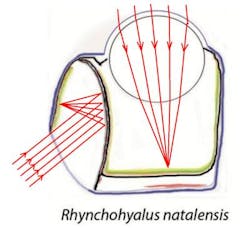Researchers at the University of Tübingen’s Institute of Anatomy (Tübingen, Germany) have discovered a fish with a previously unknown type of eye that contains two optical systems: one catoptric (mirror-based) and one dioptric (refractive).1
The aptly-named glasshead barreleye lives at depths of 800 to 1000 m. It has a cylindrical eye pointing upwards to see prey, predators or potential mates silhouetted against the gloomy light above. But the eye also has a mirror-like second lens and retina that can detect bioluminescent flashes created by deep-sea denizens to the sides and below, says researcher Hans-Joachim Wagner.
Wagner examined an 18-cm-long glasshead barreleye (rhynchohyalus natalensis) caught in the Tasman Sea between Australia and New Zealand, as part of an international research project. The results were unexpected -- reflector-based eyes are usually only found in invertebrates, such as mollusks and crustaceans, although one other vertebrate, the deep-sea brownsnout spookfish (dolichopteryx longipes) also uses a combination of reflective and refractive lenses in its eyes. The light coming from below is focused onto a second retina by a curved mirror composed of many layers of small reflective plates made of guanine crystals, giving the fish a much bigger field of vision.
Smooth mirror vs. reflective Fresnel lens
The glasshead barreleye is therefore one of only two vertebrates known to have reflector eyes; but significantly, although rhynchohyalus natalensis and dolichopteryx longipes belong to the same family, their reflective lenses have a different structure and appear to have developed from different kinds of tissue.
The glasshead barreleye has a smooth mirrored optical surface, while the brownsnout spookfish has a reflective Fresnel lens.
REFERENCE:
1. J. C. Partridge et al., Proceedings of the Royal Society B, published 19 March 2014; doi: 10.1098/rspb.2013.3223

